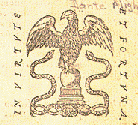
1551/52/71/75 Lyons: GUILLAUME ROVILLÉ
Guillaume Rovillé was not a publisher-printer like Jean de Tournes,
but rather a merchant-publisher and bookseller. While Rovillé was
often heavily involved in the editing, illustration and correction of his
editions, he had his books printed by master printers, forming short-term
partnerships with them for specific editions. A great number of his editions
were adorned with portraits and vignettes which if not always of high quality,
contributed nevertheless to spread the use of illustrations in books produced
in France. One of the engravers who worked most frequently with him, Pierre
Vase (Eskreich), is probably responsible for the frontispiece portrait of
Dante and the three vignettes at the head of each of the three cantiche
which illustrate Rovillé's Dante editions.
The three vignettes, including the one for the Paradiso displayed here in
the opening of Rovillé's first edition of 1551 (no. 24) were derived
from Marcolini's liberally illustrated 1544
Venetian edition of the poem with the Vellutello commentary. In fact, in
a letter addressed "To
the Readers" Rovillé remarks that since Vellutello's commentary
is "the best, in many cases we have followed him." Indeed, it
is difficult to find any original contributions by Rovillé or his
editors. Reduced and synthesized annotations based upon Vellutello's commentary
are placed conveniently at the end of each canto -- an innovative format
still followed today in some scholastic editions of the poem. In the same
letter, Rovillé promises not only new improved editions of Dante
in the future, but also "cose tuttavia di maggior importanza"
(but also things of greater importance), revealing Dante's somewhat marginalized
status as a vernacular literary classic. Rovillé's Dante editions
are dedicated
(a, b)
to the Florentine litterato Lucantonio Ridolfi (1510-1570), who had originally
come to Lyons to engage in commerce, but ended up working for Rovillé
as an editor and translator of Italian texts.
A sign of Rovillé's savvy as a marketer of books is evidenced by
his inclusion of a handy table
of difficult and obscure words appearing in the Comedy at the end
of the volume. Indeed, Rovillé's success as a publisher of Dante
is reflected in the number of his Dante imprints which reveal how, following
de Tournes's initial entry into the market in 1547, Rovillé took
over the field, printing after 1551 three subsequent editions during the
next twenty years.Generally speaking, Rovillé's publication of Italian
literary classics surpassed that of de Tournes, and is an interesting index
of the popularity of Italian literature abroad during this period: he published
five editions of Petrarch (1550, 1551, 1558, 1564 and 1574), four of Dante
(1551, 1552, 1571 and 1575), one of Boccaccio's Decameron (1555),
two of Baldassare Castiglione's Il Cortegiano (1553 and1562) and
six of Lodovico Ariosto's Renaissance bestseller, the Orlando Furioso
(1557, 1561, 1569, 1570, 1579 and 1580).
1551 Edition
1552 Edition
1571 Edition
1575 Edition

